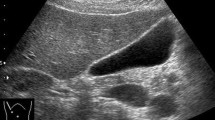Abstract
Purpose
To describe and characterize a distinctive MDCT artifact related to intra-scan transit of contrast-enhanced luminal fluid, which we term the “dense waterfall”.
Materials and Methods
179 consecutive CT colonography studies were reviewed for the presence of this distinctive artifact within the prepared and distended colon. In addition, a phantom was constructed to reproduce this artifact.
Results
A luminal artifact consisting of a starburst-like cluster of bright arciform streaks was identified within the colon in 23.5% (42/179) of patients and 19.0% (68/358) of series. The artifact was not associated with patient motion, peristalsis, or spasm but was always associated with opacified fluid actively flowing from a higher to lower level relative to the table. The average luminal fluid attenuation was 764 ± 205 HU in cases where the artifact was present, which was unchanged from cases without the artifact (762 ± 204 HU) and was not sufficiently high enough to cause obvious beam-hardening artifact in static fluid. Scans of the phantom simulation reproduced this artifact, confirming its origin.
Conclusions
Active gravitational flow of contrast-enhanced luminal fluid creates a distinctive arciform starburst artifact at MDCT that could be confused with patient motion, spasm, or beam hardening. To our knowledge, this artifact has not been previously described. Although commonly seen at CT colonography due to the specific colonic preparation and distention technique, this artifact can be seen on other abdominal MDCT studies. This artifact would generally not be confused for underlying pathology, but could potentially obscure relevant findings.





Similar content being viewed by others
References
Hsich J (2003) Computed tomography: principles, design, artifacts, and recent advances, 1st edn. Bellingham: SPIE (The International Society for Optical Engineering)
Liu F, Cuevas C, Moss AA, et al. (2008) Gas bubble motion artifact in MDCT. Am J Roentgenol (AJR) 190:294
Kim DH, Pickhardt PJ, Taylor AJ, et al. (2007) CT colonography versus colonoscopy for the detection of advanced neoplasia. New Engl J Med 357:1403
Pickhardt PJ, Choi JR, Hwang I, et al. (2003) Computed tomographic virtual colonoscopy to screen for colorectal neoplasia in asymptomatic adults. New Engl J Med 349:2191
Ritchie CJ, Godwin JD, Crawford CR, et al. (1992) Minimum scan speeds for suppression of motion artifacts in CT. Radiology 185:37
McCollough CH, Bruesewitz MR, Daly TR, et al. (2000) Motion artifacts in subsecond conventional CT and electron-beam CT: pictorial demonstration of temporal resolution. Radiographics 20:1675
Author information
Authors and Affiliations
Corresponding author
Rights and permissions
About this article
Cite this article
Boyce, C.J., Vetter, J.R. & Pickhardt, P.J. MDCT artifact related to the intra-scan gravitational flow of opacified luminal fluid (the “Dense Waterfall” sign). Abdom Imaging 37, 292–296 (2012). https://doi.org/10.1007/s00261-011-9731-z
Published:
Issue Date:
DOI: https://doi.org/10.1007/s00261-011-9731-z




